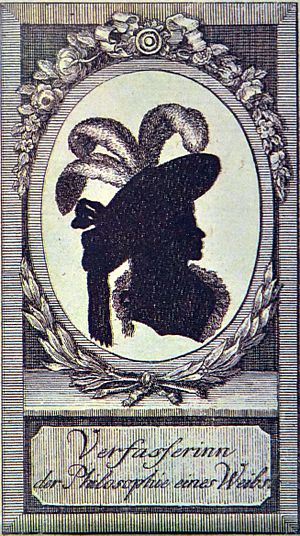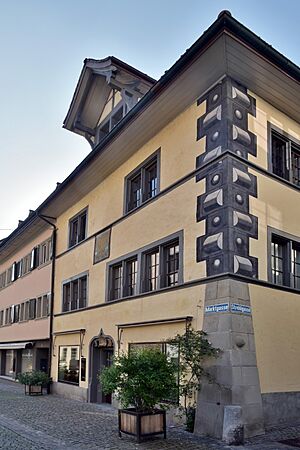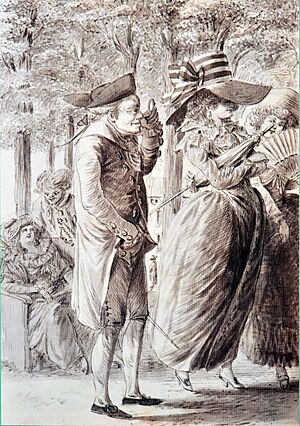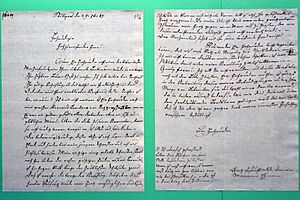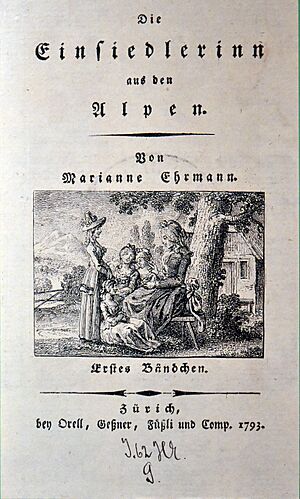Marianne Ehrmann facts for kids
Marianne Ehrmann (born November 25, 1755; died August 14, 1795) was a pioneering woman writer. She was one of the first women to become a novelist, a publicist, and a journalist in German-speaking countries. She used other names like Marianne Ehrmann-Brentano and Madame Sternheim.
Contents
Life and Career
Early Life and Challenges
Marianne Ehrmann was born in Rapperswil, Switzerland. Her father, Franz Xaver Brentano, was a merchant. She had nine brothers and sisters.
When she was a teenager, her mother passed away. A few years later, her father also died. Marianne then moved to live with her uncle, Dominic von Brentano, who was a priest. He helped her in the following years. Marianne worked as a governess, teaching children in wealthy families.
Around 1777, Marianne married an officer. However, this marriage was very difficult and ended in divorce in 1779. After this tough time, her uncle helped her recover.
Becoming an Actress
About three years later, Marianne moved to Vienna. She tried working as a governess again, but it didn't work out. So, she decided to join a group of actors. She performed on stage for several years using the name Madame Sternheim.
Marianne traveled with different theater groups. She performed in many countries, including Austria, France, Germany, Holland, Switzerland, and even Hungary.
During her time with a theater group in Strasbourg, she met Theophil Friedrich Ehrmann. He was a lawyer. In 1785, they got married in secret. Theophil's parents were not happy about the marriage at first. But by 1786, they accepted Marianne.
In 1786, Marianne Ehrmann published a play. She used the name Maria Anna Antonia Sternheim. The play was called "Frivolity and a Good Heart, or The Consequences of Education." Later, Marianne and Theophil moved to Stuttgart. Marianne started working with her husband on a newspaper called Der Beobachter (The Observer).
A Pioneer in Journalism
Marianne Ehrmann became one of the first women journalists and writers in German-speaking countries. In 1784, she wrote an essay called "Philosophy of a Woman." It was very successful.
In 1788, she wrote a novel called "Amalie: A True Story in Letters." This book was based on her own life experiences. She also wrote for the Frauen-Zeitung (Women's Newspaper). From 1790 to 1792, she started her own monthly magazine for women. It was called Amaliens Erholungsstunden (Amalie's Holiday Hours). This magazine was very important for its time.
Amaliens Erholungsstunden
Marianne Ehrmann first published Amaliens Erholungsstunden herself. She sent announcements to friends and people who might be interested. The magazine became popular, and the number of readers grew.
However, publishing it herself was expensive. So, in 1791, Marianne and her husband teamed up with a publisher named Johann Friedrich Cotta. Marianne wanted to focus on writing and editing. The magazine was very successful, with about 1,000 copies sold each month. This was a lot for a women's magazine back then.
The magazine aimed to help women from the middle class. It encouraged them to share their own thoughts and opinions. Over time, the publisher started changing the content. They made it more simple and less serious. This was against Marianne Ehrmann's wishes. Because of these changes, Marianne and Theophil decided to stop working with Cotta.
After they left, Cotta started a new magazine called Flora. He used the list of readers from Marianne's old magazine. Marianne Ehrmann then began a new magazine of her own. It was called Einsiedlerinn aus den Alpen (The Woman Hermit in the Alps). She wrote most of the articles herself again.
Einsiedlerinn aus den Alpen
In 1792, Marianne Ehrmann found a new publisher in Zürich, Switzerland. This allowed her to continue her work as a writer and editor. In December 1792, the first issue of Einsiedlerinn aus den Alpen came out. It was the first magazine edited by a woman in Switzerland.
Marianne had to find new readers for this magazine. She and her husband told their old readers about the new publication. The new partnership with the publisher helped Marianne financially.
Einsiedlerinn aus den Alpen was similar to her first magazine. It featured true stories and novels published in parts. Marianne Ehrmann was in charge of editing the magazine. She also found other writers to contribute. Some of her friends, like David Friedrich Gräter, wrote for the magazine.
Marianne faced health problems during this time. This sometimes delayed the magazine's publication. By June 1795, she finished the last issue. Due to her ongoing illness, she decided to stop working on the journal.
Death and Legacy
Marianne Ehrmann died in Stuttgart on August 14, 1795. She was only 39 years old. She passed away from pneumonia.
After her death, some of her unfinished writings were published in 1796. They were called Amaliens Feierstunden (Amalie's Celebration Hours). Marianne Ehrmann had a big dream. She wanted women to be independent and to have their own publications. While her full vision took a long time to come true, people at the time saw her as a deep thinker. She was an important figure in the Age of Enlightenment, a time when new ideas about reason and individual rights were popular.
Works
- 1784: Philosophie eines Weibs: Von einer Beobachterin. (Philosophy of a Woman: By an Observer.)
- 1786: Leichtsinn und gutes Herz oder die Folgen der Erziehung. (Frivolity and a Good Heart, or The Consequences of Education.) (play)
- 1787: Amalie and Minna (novel)
- 1788: Amalie: Eine wahre Geschichte in Briefen (Amalie: A True Story in Letters) (novel)
- 1790–1792: Amaliens Erholungsstunden (Amalie's Holiday Hours) (monthly women's magazine)
- 1793–1794: Die Einsiedlerinn aus den Alpen (The Woman Hermit in the Alps) (women's magazine)
- 1796: Amaliens Feierstunden (Amalie's Celebration Hours) (published after her death)
Literature
- Mary Helen Dupree: The Mask and the Quill. Actress-Writers in Germany from Enlightenment to Romanticism. Bucknell University Press, Bucknell PA 2011.
- Ruth P. Dawson: "Confronting the Lords of Creation: Marianne Ehrmann (1755–95). The Contested Quill: Literature by Women in Germany 1770-1880. Newark, Del.: University of Delaware, 2002.
- Helga Stipa Madland: Marianne Ehrmann: Reason and Emotion in her Life and Works. Peter Lang, New York 1998.


